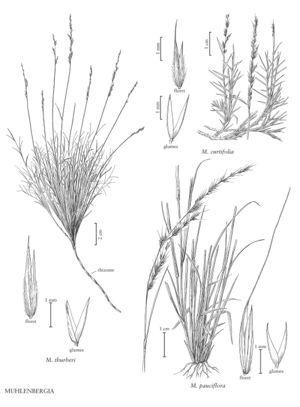Muhlenbergia thurberi
Plants perennial; rhizomatous, not cespitose. Culms 12-36 cm tall, 0.3-0.5 mm thick, often clumped, usually erect, somewhat decumbent at the base; internodes mostly or completely glabrous, sometimes strigose below the nodes. Sheaths shorter than the internodes, hirtellous near the margins; ligules 0.9-1.2 mm, membranous, truncate to obtuse, erose; blades 0.2-3.7 cm long, 0.2-1 mm wide, tightly involute, straight to arcuate, smooth or scabridulous abaxially, hirtellous adaxially. Panicles 0.7-5.5 cm long, 0.2-0.7 cm wide, contracted, not dense, sometimes interrupted below; primary branches 0.4-1.8 cm, appressed; pedicels 0.1-4 mm. Spikelets 2.6-4 mm. Glumes subequal, 1.6-3 mm, 1-veined, scabridulous on the veins, acute, unawned; lemmas 2.6-4 mm, lanceolate, hairy on the lower 3/4, hairs to 1.2 mm, tawny, apices acuminate, unawned or awned, awns to 1 mm; paleas 2.6-4 mm, lanceolate, intercostal region tawny pubescent; anthers 2.1-2.3 mm, yellowish-purple. Caryopses 2-2.2 mm, fusiform, light brownish. 2n = unknown.
Distribution
Utah, Ariz., Colo., N.Mex., Nev.
Discussion
Muhlenbergia thurberi usually grows in moist soil in seeps near canyon cliffs, sandstone slopes, and rocky ledges, at elevations of 1350-2300 m. The species appears to be restricted to the southwestern United States. It flowers from July to September.
Muhlenbergia thurberi resembles M. curtifolia, but differs in its tightly involute blades, and longer anthers and ligules. The two species have been found growing within 50 m of each other in Apache County, Arizona, but in different habitats, M. curtifolia growing in a damp drainage areas whereas M. thurberi grew near a moist but dryer canyon cliff.
Selected References
None.
